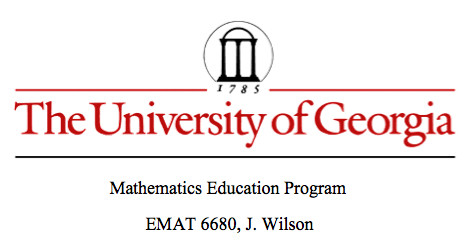

Orthocenters and Circumcircles
by
Laura Kimbel

Above, is a picture of 4 orthocenters and 4 circumcircles constructed from 4 different triangles. First, I constructed the orthocenter of triangle ABC, and labeled it H. Next, I constructed the orthocenter of the triangle formed by joining vertices B and C with orthocenter H. The orthocenter of HBC is H'' and lies on vertex A. Similarly, I constructed the orthocenter H''' for triangle HAB which lies on vertex B.
If we look at the centers of these circles and draw in the segments joining the centers of the circles to the vertices of our original triangle, we have more triangles to observe.

Each of these new triangles is isosceles. We know this because the dashed lines make up 2 sides of each of our triangles and are simultaneously radii of their circumcircles. Also, all of our circles are equal in area, which means their radii have the same length. This means all our dashed lines in the picture above are equal in length. Another thing to notice is that each of our circles, except for the pink circle, all contain the point H. This is because the circumcircle goes through the 3 vertices of the triangle and H is a common point.
What if we move one of our vertices A, B, or C such that it is located where H is?

After moving point B such that it lies on point H, we see that now our blue circle and pink circle coincide. Now all circles intersect at point H, and H is still the orthocenter of our new triangle. The type of triangle with these qualities (the triangle above) is a right triangle. The reason for this is because the orthocenter is the intersection of the altitudes and now, 2 of our sides coincide with 2 of the altitudes.